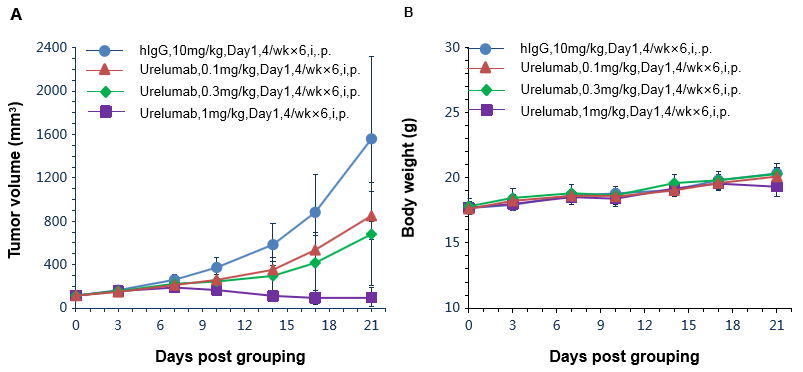靶點人源化小鼠是指將藥物靶點或疾病相關的人源蛋白敲入並破壞鼠同源蛋白的動物模型。該小鼠模型具有功能健全的免疫係統,可用於免疫治療的藥效評價;同時,由於使用人源蛋白替換了鼠同源蛋白,克服了部分抗體不能人鼠交叉識別的問題,可使用人源或人源化抗體藥物進行藥效評價,解決了以往隻能使用替代抗小鼠抗體進行藥效評價的難點,在提高藥物研發轉化率的同時,極大降低了研發成本。此外,相比於免疫缺陷鼠人免疫重建模型,具有更高的成本效益和結果穩定性。
尊龙凯时人生就是搏官网根據目前新藥研發市場需求,開發了一係列單靶點/雙靶點或多靶點人源化小鼠模型,並根據可能的藥物作用機理,開發了相應的人源化腫瘤細胞係,以提供更加完善和有效的藥效評價疾病模型。
目前可提供服務的人源化小鼠模型主要包括免疫檢查點人源化、細胞因子人源化、GPCR人源化和其他人源化小鼠,詳細信息可在人源化動物模型部分查看。
模型數據展示

Gene description
TNFRSF9 (Tumor necrosis factor receptor super family, member 9), also called CD137 and 4-1BB, is a co-stimulatory molecule and is mainly expressed on the surface of T, B, NK and mononuclear cells. CD137 is activated by its ligand CD137L or activating anti-CD137 antibodies enhance tumor rejection because it is upregulated on T cells following activation and its engagement increases T cell proliferation and pro-inflammatory cytokine production. The clinical development of 4-1BB targeting therapy was slow due to the toxicity associated with overt immune activation. Fortunately, new therapeutic modalities using 4-1BB targeting aptamers as well as therapeutic combinations with other immuno-modulatory and traditional anti-cancer treatments have revived excitement for the use of 4-1BB agonists in the clinical.
Protein expression analysis

Strain specific 4-1BB protein expression analysis in wild-type (+/+) or homozygous B-h4-1BB (H/H) mice by flow cytometry. Splenocytes were collected from +/+ and homozygous mice stimulated with anti-CD3ε in vivo, and analyzed by flow cytometry with species-specific anti-4-1BB antibodies. Mouse 4-1BB was detectable in +/+ mice, while human 4-1BB was exclusively detectable in B-h4-1BB H/H mice.
High dose of urelumab resulted in liver toxicity in B-h4-1BB mice

High dose of urelumab therapy resulted in increased lymphocyte infiltration in liver in B-h4-1BB mice

Pathological analysis of liver toxicity. Chronic inflammation (arrow) was observed in the liver of B-h4-1BB mice which were treated with high dose (20mg/kg) of urelumab (in house) for 21 days. While there were no microscopic changes in groups G1 and G3 which respectively treated with low dose (1mg/kg) of urelumab (in house) and high dose (20mg/kg) of Isotype.

Antitumor activity of anti-human 4-1BB antibodies in B-h4-1BB mice. (A) Anti-human 4-1BB antibodies inhibited MC38 tumor growth in B-h4-1BB mice. Murine colon cancer MC38 cells were subcutaneously implanted into homozygous B-h4-1BB mice (female, 6-7 week-old, n=6). Mice were grouped when tumor volume reached approximately 100 mm3, at which time they were treated with anti-human 4-1BB antibody urelumab (in house) with doses and schedules indicated in panel. (B) Body weight changes during treatment. As shown in panel A, anti-human 4-1BB antibodies were efficacious in controlling tumor growth in B-h4-1BB mice, demonstrating that the B-h4-1BB mice provide a powerful preclinical model for in vivo evaluation of anti-human 4-1BB antibodies. Values are expressed as mean ± SEM.
腫瘤相關抗原(Tumor-associated antigens,TAA)是指在腫瘤細胞特有或高表達,而在健康細胞上不存在或低表達的抗原分子,參與腫瘤細胞的增殖、分化和遷移,這使得TAA成為潛在的抗腫瘤藥物有效分子靶點。TAA靶點相關藥物能夠通過介導ADCC、CDC、激活免疫反應等作用殺傷腫瘤細胞。針對該類型藥物,可使用野生型小鼠皮下接種/原位接種經過人源化改造的鼠源細胞係進行藥效評價。
尊龙凯时人生就是搏官网根據目前TAA靶點藥物研發市場需求,開發了一係列人源化細胞係,可用於藥效評價。
*部分TAA靶點在健康組織和細胞中表達,並發揮重要的生理功能,針對這類靶點的藥物可能發生嚴重的毒副作用,尊龙凯时人生就是搏官网可提供相應人源化動物模型,進行藥物的安全性評價。
|
310705 |
B-hB7-H3 EL4 |
310708 |
B-hEPCAM MC38 |
|
310704 |
B-hB7-H3 MC38 |
310825 |
B-hFAP MC38 |
|
310720 |
B-hBCMA MC38 |
310724 |
B-hHER2 EL4 |
|
310712 |
B-hCD19 EL4 |
311147 |
B-hHLA-E MC38 |
|
310706 |
B-hCD19 MC38 |
310693 |
B-hHVEM MC38 |
|
310717 |
B-hCD20 EL4 |
310815 |
B-hLILRB4 MC38 |
|
310716 |
B-hCD20 MC38 |
311600 |
B-hMERTK MC38 |
|
310976 |
B-hCD37 MC38 |
320714 |
B-hPD-L1/hCD47 MC38 |
|
310695 |
B-hCD47 MC38 |
320722 |
B-hPD-L1 plus/hCEA MC38 |
|
310690 |
B-hCEACAM1 MC38 |
310703 |
B-hPD-L2 MC38 |
|
310791 |
B-hCLDN18.2 A549 |
310807 |
B-hROR1 MC38 |
|
310715 |
B-hCLDN18.2 MC38 |
311082 |
B-hTF MC38 |
|
310824 |
B-hCXCR2 MC38 |
311068 |
B-hTPBG MC38 |
|
310896 |
B-hCXCR4 MC38 |
310702 |
B-hCD47 CT26.WT |
|
310713 |
B-hEPCAM EL4 |
310696 |
B-hCD47 MC38 |



 京公網安備: 11011502005564號
京公網安備: 11011502005564號






